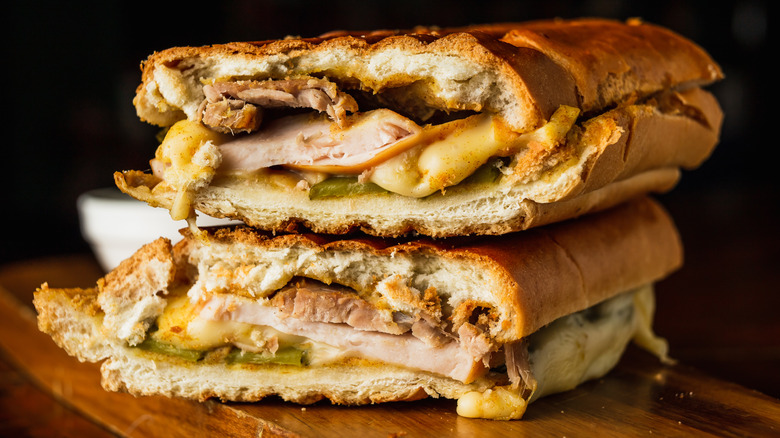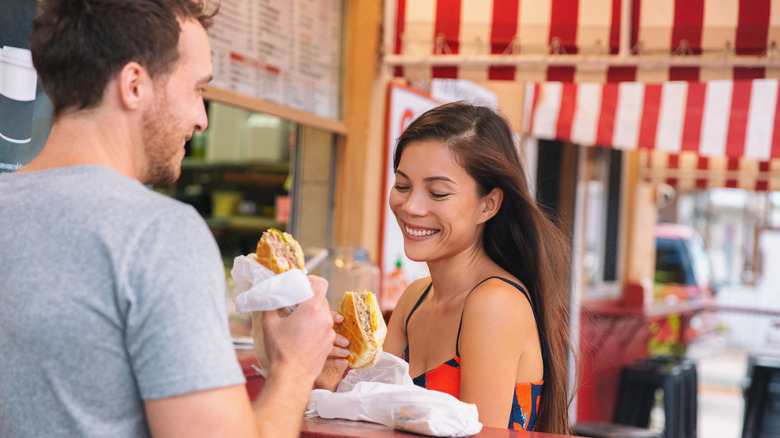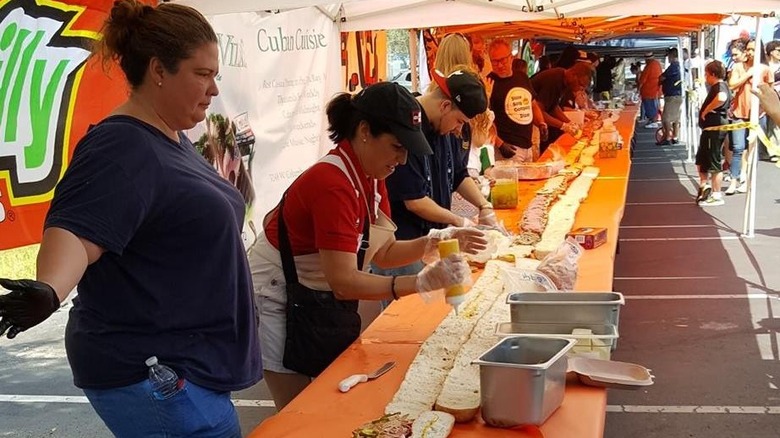The Cuban Sandwich Rivalry That Turned Into A Yearly Festival
Ham and marinated pork, along with mustard, pickles, Swiss cheese, and of course pressed Cuban bread are all staple elements in this now iconic sandwich. As with many of the world's great culinary achievements, scant evidence exists to pinpoint the exact origin and evolution of the Cuban sandwich — beyond the incontrovertible fact that it was invented by Cubans. Whether it was actually invented in Cuba or not is a different story, as most claims to this effect are cultural rather than historical, with credit given to the indigenous Taino population. Despite the fact that their bread was made with yucca, and pork products were unknown on the Caribbean island before the period of Spanish colonization.
Better evidence exists that the Cuban sandwich was actually created by Cuban immigrant populations in Florida. Nearly one million Cubans immigrated to the U.S. between 1870 and 2000, with the majority settling in the Sunshine State. In fact, two Florida cities, Tampa and Miami, both claim ownership of the meaty sandwich. The heated rivalry that has developed between the two cities over this historical precedent has become exacerbated even further by arguments over how it should be made. Tampa's version, for example, famously includes Genoa salami.
Did Tampa or Miami make the Cuban Sandwich popular?
Cuban cigar rollers and others in the industry began moving to Key West in earnest in the 1870s, and to Tampa a decade later, with the community centered around the Ybor City neighborhood. As this immigrant community grew, restaurants followed, including Casimiro Hernandez Sr.'s Columbia Restaurant in 1905. Whether the original Cuban sandwiches there had Genoa salami or not is doubtful, but Columbia Restaurant established the Cuban sandwich in Tampa in the early days of the 20th century.
Miami cannot compete with Tampa when it comes to history, as the former city established its Cuban culinary culture much later — large-scale immigration to Miami began after the Cuban Revolution in the late 1950s. So the controversy which has arisen between Miami and Tampa really isn't about origins. It's about who made it popular, and who is more associated with the iconic sandwich. As Miami Museum's Dr. Paul George notes in Thrillist, "Tampa predates Miami in terms of its origin. But Miami has such a large Cuban population, which made the sandwich really pervasive. Instead of it being confined to small neighborhoods in Tampa, Miami made it mainstream."
The good news for connoisseurs of the sandwich is that out of this rivalry, a festival has grown. The International Cuban Sandwich Festival has been held in Centennial Park, in Tampa's Ybor City neighborhood, every year since 2012.
No controversy surrounds the invention of the Cuban Sandwich Festival
Some might argue that Tampa, by originating the International Cuban Sandwich Festival, is attempting to bolster its claims to have invented the sandwich. But that argument has largely been settled, and in any case, the festival wasn't invented by a city. Rather, it was the brainchild of Victor Padilla and his wife, Jolie Gonzalez-Padilla. The two created the festival in 2012 and helped to associate it with a good cause, namely, feeding the homeless.
One of the ways the festival accomplishes this is via gigantic sandwiches. In 2012, for example, a 36-foot-long sandwich was built as part of the festival's mission to help nourish Tampa's homeless population. By 2020, this had grown to a record-breaking 200-foot-long Cuban sandwich. The goal for this year's festivities, scheduled to take place May 27 and 28, is even more ambitious — a 280-footer that can satisfy more than 700 people.
The international aspect of the International Cuban Sandwich Festival is not merely a nod to the sandwich's roots in Cuban culture. The festival draws entries from around the world. A Seoul, Korea-based sandwich shop, Tampa Sandwich Bar, for instance, took top honors in terms of popularity at both the 2017 and 2018 iterations of the festival. Looks like whichever city made this sandwich popular did a great job because it certainly seems to have a global audience.


